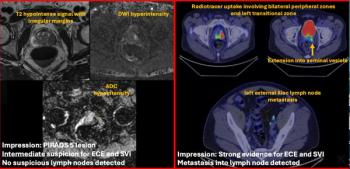
MRI Technique Could Reduce Radiation Dose in Assessing Pediatric Cancer Treatment
NIH-funded study reveals using diffusion-weighted MRI to evaluate therapy effectiveness could reduce dose by 80 percent.
Using whole body diffusion-weighted magnetic resonance imaging (DW MRI) to evaluate the efficacy on cancer treatment in children can potentially provide a more than three-quarters cut in radiation exposure, according to new research.
A study, funded by the National Institutes of Health (NIH), published today in
The researchers had financial support from the NIH Eunice Kennedy Shriver National Institute of Child Health and Human Development (NICHD).
To determine whether this technique was feasible and effective, investigators, led by Heike E. Daldrup-Link, M.D., Ph.D., of Stanford University, compared DW MRI to an established technique – fluorine 18 fluorodeoxyglucose positron emission tomography (FDG PET). DW MRI measures tumor density by tracking water molecule movement in tissue, and FDG PET is frequently used with CT to measure tumor metabolism after radioactive glucose injection.
According to study results, DW MRI performed with similar sensitivity and specificity to FDG PET. This outcome presents the possibility that DW MRI could be used either in place of CT scanning, together with FDG PET, as a stand-alone assessment without radioactive glucose. Together with FDG PET, DW MRI could reduce radiation exposure by 80 percent and could eliminate it completely if it were used alone.
“Advances in pediatric cancer treatment have led to more survivors, but radiation exposure from current imaging techniques raises the risk of new cancers later in life,” said Geoge P. Giacoia, M.D., from the Obstetric and Pediatric Pharmacology and Therapeutics Branch at NICHD.
For this study, researchers conducted 112 DW MRI and FDG PET scans on 56 children and young adults, ages 6 to 22, constituting what they said is likely the largest number of PET/MRI scans on a pediatric population to date. All participants either had lymphoma or sarcoma. These were the only two tumor types included in the study, investigators said, because pediatric cancers are rare.
Individuals underwent the two scans simultaneously before their treatment began, and, then, again after the first few weeks of chemotherapy. Such an early evaluation gave providers the opportunity to switch to a potentially more effective therapy option if continued tumor growth was detected.
According to data analysis, Daldrup-Link’s team reported, both DW MRI and FDG PET mainly produced equivalent results, though FDG PET picked up on therapy response in some patients sooner than DW MRI. Sensitivity and specificity were 96 percent and 100 percent, respectively, for DW MRI. For FDG PET/MRI, they were 100 percent and 100 percent.
The study results are promising, Giacoia said, but additional studies must be conducted to confirm the findings and impact.
Newsletter
Stay at the forefront of radiology with the Diagnostic Imaging newsletter, delivering the latest news, clinical insights, and imaging advancements for today’s radiologists.




























